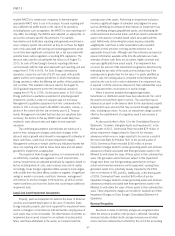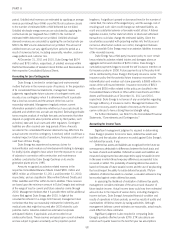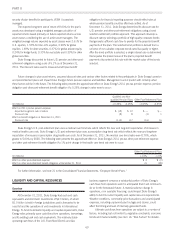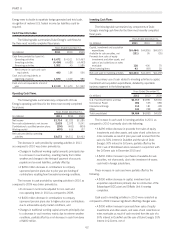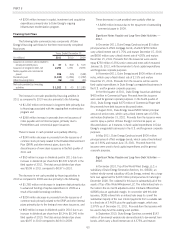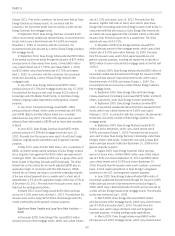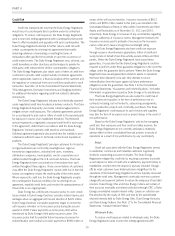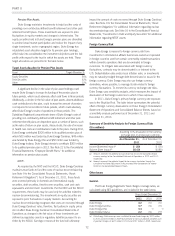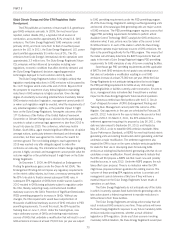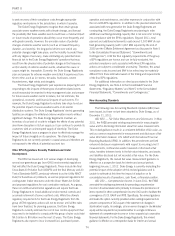Duke Energy 2011 Annual Report Download - page 85
Download and view the complete annual report
Please find page 85 of the 2011 Duke Energy annual report below. You can navigate through the pages in the report by either clicking on the pages listed below, or by using the keyword search tool below to find specific information within the annual report.
PART II
rate of 6.45% and mature April 1, 2039. Proceeds from this
issuance were used to fund capital expenditures, to replenish cash
used to repay $97 million of senior notes which matured on
March 15, 2009, to fund the repayment at maturity of $125 million
of first mortgage bonds due July 15, 2009, and for general corporate
purposes, including the repayment of short-term notes.
In January 2009, Duke Energy issued $750 million principal
amount of 6.30% senior notes due February 1, 2014. Proceeds
from the issuance were used to redeem commercial paper and for
general corporate purposes.
In January 2009, Duke Energy Indiana refunded $271 million
of tax-exempt auction rate bonds through the issuance of $271
million of tax-exempt variable-rate demand bonds, which are
supported by direct-pay letters of credit, of which $144 million had
initial rates of 0.7% reset on a weekly basis with $44 million
maturing May 2035, $23 million maturing March 2031 and $77
million maturing December 2039. The remaining $127 million had
initial rates of 0.5% reset on a daily basis with $77 million maturing
December 2039 and $50 million maturing October 2040.
Credit Facilities
Master Credit Facility Summary as of December 31, 2011 (in millions)(a)(b)
Duke Energy
Duke Energy
Carolinas
Duke Energy
Ohio
Duke Energy
Indiana Total
Facility Size(c) $1,250 $1,250 $800 $ 700 $4,000
Less:
Notes Payable and Commercial Paper(d) (75) (300) — (150) (525)
Outstanding Letters of Credit (51) (7) (27) — (85)
Tax-Exempt Bonds — (95) (84) (81) (260)
Available Capacity $1,124 $ 848 $689 $ 469 $3,130
(a) This summary only includes Duke Energy’s master credit facility and, accordingly, excludes certain demand facilities and committed facilities that are insignificant in size or which
generally support very specific requirements, which primarily include facilities that backstop various outstanding tax-exempt bonds. These facilities that backstop various outstanding
tax-exempt bonds generally have non-cancelable terms in excess of one year from the balance sheet date, such that the Duke Energy Registrants have the ability to refinance such
borrowings on a long-term basis. Accordingly, such borrowings are reflected as Long-term Debt on the Consolidated Balance Sheets of the respective Duke Energy Registrant.
(b) Credit facility contains a covenant requiring the debt-to-total capitalization ratio to not exceed 65% for each borrower.
(c) Represents the sublimit of each borrower at December 31, 2011. The Duke Energy Ohio sublimit includes $100 million for Duke Energy Kentucky.
(d) Duke Energy issued $450 million of Commercial Paper and loaned the proceeds through the money pool to Duke Energy Carolinas and Duke Energy Indiana. The balances are classified
as long-term borrowings within Long-term Debt in Duke Energy Carolina’s and Duke Energy Indiana’s Consolidated Balance Sheets. Duke Energy issued an additional $75 million of
Commercial Paper in 2011. The balance is classified as Notes payable and commercial paper on Duke Energy’s Consolidated Balance Sheets.
In November 2011, Duke Energy entered into a new $6 billion,
five-year master credit facility, with $4 billion available at closing and
the remaining $2 billion available following successful completion of
the proposed merger with Progress Energy. The Duke Energy
Registrants each have borrowing capacity under the master credit
facility up to specified sublimits for each borrower. However, Duke
Energy has the unilateral ability at any time to increase or decrease
the borrowing sublimits of each borrower, subject to a maximum
sublimit for each borrower. See the table above for the borrowing
sublimits for each of the borrowers as of December 31, 2011. The
amount available under the master credit facility has been reduced,
as indicated in the table above, by the use of the master credit facility
to backstop the issuances of commercial paper, letters of credit and
certain tax-exempt bonds.
In April 2010, Duke Energy and Duke Energy Carolinas entered
into a $200 million four-year unsecured revolving credit facility,
which expires in April 2014. Duke Energy and Duke Energy
Carolinas are Co-Borrowers under this facility, with Duke Energy
having a borrowing sub limit of $100 million and Duke Energy
Carolinas having no borrowing sub limit. Upon closing of the facility,
Duke Energy made an initial borrowing of $75 million for general
corporate purposes, which is classified as Long-term debt on the
Consolidate Balance Sheets.
In September 2008, Duke Energy Indiana and Duke Energy
Kentucky collectively entered into a $330 million three-year letter of
credit agreement with a syndicate of banks, under which Duke
Energy Indiana and Duke Energy Kentucky may request the issuance
of letters of credit up to $279 million and $51 million, respectively,
on their behalf to support various series of variable rate demand
bonds issued or to be issued on behalf of either Duke Energy Indiana
or Duke Energy Kentucky. This credit facility may not be used for any
purpose other than to support the variable rate demand bonds issued
by Duke Energy Indiana and Duke Energy Kentucky. In September
2010, the letter of credit agreement was amended to reduce the size
to $327 million and extend the maturity date to September 2012. In
September 2011, the maturity date for the agreement was extended
to December 2012 and in December 2011, the maturity date was
extended to March 2013 and the facility size was reduced to $208
million. The facility was subsequently terminated in February 2012.
In January 2012, Duke Energy Indiana and Duke Energy
Kentucky collectively entered into a $156 million two-year bilateral
letter of credit agreement, under which Duke Energy Indiana and
Duke Energy Kentucky may request the issuance of letters of credit
up to $129 million and $27 million, respectively, on their behalf to
support various series of variable-rate demand bonds. In addition,
Duke Energy Indiana entered into a $78 million two-year bilateral
letter of credit facility. These credit facilities may not be used for any
purpose other than to support the variable rate demand bonds issued
by Duke Energy Indiana and Duke Energy Kentucky. In February
2012, letters of credit were issued corresponding to the amount of
the facilities to support various series of tax-exempt bonds at Duke
Energy Indiana and Duke Energy Kentucky.
Duke Energy’s debt and credit agreements contain various
financial and other covenants. Failure to meet those covenants
65




